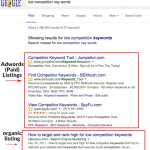Data-backed insights on featured bit optimization

99 percent of all included bits tend to appear within the first organic position and take control of seo agency 50% of the screen on mobile devices, driving higher-than-average click-through rates (CTR).
The secret to featured snippet optimization depends on a few specific locations: long-tail- and question-like keyword technique, date significant material that comes at the right length and format, and a concise URL structure.
Google has constantly been pretty hazy on any information about winning featured snippets. This was the case when they were initially introduced, making them something companies considered to be the cherry on top of their SEO efforts, which is still largely the case. Having first-hand understanding about the value and power of featured snippets, Brado coordinated with Semrush to carry out the most extensive research around featured bit optimization to reveal how they truly work, and what you can do to win them.
Exposing the highlights from a Featured bits study that analyzed over a million SERPs with highlighted bits present, this post unwraps actionable recommendations on amping up your optimization strategy to finally win that Google reward.
General patterns across the included bit landscape.
With billions of search queries go through the Google search box every day, our research study found that around 19 percent of keywords activate a highlighted snippet. Why does this even matter? Featured snippets are understood to drive greater CTR-- as another study revealed, they are accountable for over 35 percent of all clicks.
Additional showing the tremendous power of featured snippets, our study revealed that they use up over half of the SERP's property on mobile screens.
Integrate this with our findings that 99 percent of the time featured snippets take over the first natural position, which they are in the majority of cases triggered by long-tail keywords (implying specific user intent), and you'll get the factor behind exceptionally high CTR numbers.
Are some markets most likely to trigger highlighted snippets?
In the study, we defined industries by keyword categories, discovering that, certainly, featured bit volume is inconsistent throughout different segments.The leading market, seeing an included snippet in 62 percent of all cases, is Travel and Computer & Electronics, followed by Arts & Entertainment (59 percent), and Science (54 percent), while Realty keywords lag behind all the rest with only 11 percent of keywords setting off a featured bit.
featured snippet optimization insights on keyword categories that set off.
On a domain level, the market breakdown differs a little, with Health and News websites having comparable featured snippet volumes.
You can discover the full market breakdown within the study.
Featured bits are all about earns, not wins.
Just hoping your material will win you an included snippet isn't enough-- as our study showed, it's all about hard-earned material optimization results.
1. Optimize for long-tail keywords and concerns.
When it comes to optimization and keywords, use 'the more the better' logic.
Our study discovered that 55.5 percent of highlighted bits were activated by 10-word keywords, while single-word ones only appeared 4.3 percent of the time.
Something even much better than long-tails is concerns. 29 percent of keywords setting off a featured snippet start with question words-- "why" (78 percent), "can" (72 percent), "do" (67 percent), and in the fewest cases, "where" (19 percent).
included snippet optimization insights on concern keywords that set off.
2. Utilize the best material length and format.
The SERPs we analyzed consisted of four kinds of highlighted snippet: paragraphs, lists, tables, and videos:.
70 percent of the results revealed paragraphs, with an average of 42 words and 249 characters.
Lists came in as the second-most-frequent featured snippet (19 percent), with approximately 6 product counts and 44 words.

Videos, whose average duration stood at 6:39 mins, showed up in only 4.6 percent of all cases.
Of course, don't blindly follow this information as the golden rule, rather see it as a great beginning point for featured-snippet-minded content optimization.Plus, keep in mind that content quality always prevails over quantity, so if you have a high-performing piece that includes a 10-row table, Google will just cut it down, showing the blue "More rows" link, which can even boost your CTR.
3. Do not overcomplicate your URL structure.
As it turns out, URL length matters in Google's option of a website that should have a featured bit. Try to stick to cool website architecture, with 1-3 subfolders per URL, and you'll be most likely to win.

Simply for reference, here is an example of a URL with three subfolders:.
xyz.com/subfolder1/subfolder2/subfolder3.
4. Make frequent content updates.
In the "to add or not to add a post date" predicament, based upon our featured bit analysis, we 'd suggest that you release date-marked material.
Most of Google's featured bits consist of a short article date, with the following breakdown: 47 percent of list-type featured bits originate from date-marked content, paragraphs-- 44 percent, videos-- 20 percent, and tables-- 19 percent of the time.
While fresh-out-of-the-oven material can be favored by Google, 70 percent of all content making it into the included bit was anywhere from 2 to 3 years of ages (2018, 2019, 2020), suggesting when again that content quality matters more than recency, so you should not stress that putting a date on it will work against you.